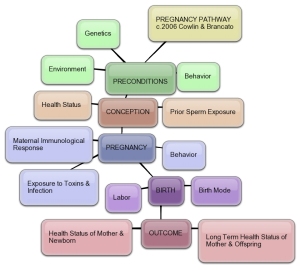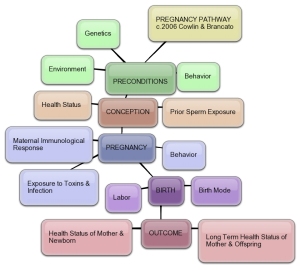American College of Nurse Midwives updates
Two updates on the ACNM website of interest:
• the value of exercise in pregnancy
• health care reform
Check out the ACNM site!!
Two updates on the ACNM website of interest:
• the value of exercise in pregnancy
• health care reform
Check out the ACNM site!!
Check out this video, DTP contributed content. Back care in pregnancy and postpartum.
Today: Maternal Immunological Response…or…the Mother/Fetus Dance!

Maternal Immune Response During Pregnancy
Back to work! Thank you for your forebearance while we wrote a chapter for a nursing textbook!
During the course of pregnancy, the mother/fetus dance is ongoing. The maternal immune system and the trophoblast cells continue to influence each other even beyond the implantation.
Because the mother’s immune response modulates near the start of each trimester, the fetus is affected to some degree and mounts a response, as well. For a long time it was thought that maternal and fetal DNA material was not exchanged across the placental membrane, however recent findings indicate that there is some exchange of material. Thus, we all carry some portion of our mother’s DNA and our mother carries some of ours.
What is the impact of this chimeric effect? It depends on how well our DNA gets along!
How does this affect the fetus in utero? The fetus may be affected by clotting issues. Depending on maternal health status s/he may be subject to a stronger or weaker immune system.
How does this affect the mother? Women are more likely than men to develop autoimmune disorders (pregnancy playing a role here), and those who bear male offspring are more likely than those who only have girls to have these disorders.
The maternal/fetal dance goes on.…

Be Prepared for Birth!
REVIEW: Evidence is clear - pre-pregnancy maternal health status, including physical fitness, healthy nutrition and an uncompromised immune system affect the health and well-being of both mother and offspring, in both short and long term.
This is the message summary from our first two areas of discussion: Preconditions and Conception — the green and sand colored sections on the chart below.

COMING ATTRACTIONS: We are about to move on to the blue section — Pregnancy!! So, bookmark this Blog for future reference!
Also, you can subscribe to this Blog by clicking on Blog Info in the upper right corner and then clicking on Subscribe in the drop down menu.
But, yes, you guessed it, first we have a small rant!
SMALL RANT: When we note that fitness, nutrition and a healthy immune system play significant roles in the outcome of pregnancy and the future health of mother and child, we are appealing to young people of childbearing age to be careful about your bodies. The alliance of egg and sperm shapes the world. With 6.5 Billion egg/sperm combinations (yes, people) presently living on earth, our resources are stretched. With time, either we get more picky about doing this, or the 3rd rock from the sun (remember that show?) is cooked.
Humorous incursion: In case you need further enlightenment on this whole area, there is a great website that will help you out. Be prepared to be amused and amazed!
The Truth about Eggs and Sperm
Hopefully, this gets you in the right mood and keeps you smiling. After all, once you actually are pregnant, we have more serious matters to discuss.
Today: Conception!
For complete graphic, see Feb. 5 or 23 post.

The health of the mother and her prior exposure to sperm have a dramatic effect on conception. To find out why and how, we have to start with this question:
What is conception?
Is it fertilization, a process by which an egg absorbs a sperm, engulfing the male’s half of the genetic code? Perhaps it is the point at which this egg/sperm concoction (the corpus) reaches the uterus and the trophoblast cells begin to invade the endometrium (uterine lining)?

Trophoblast Invastion? No…Chihuly glass exhibit at the Desert Botanical Gardens, Phoenix AZ
Trophoblast invasion causes spiral arteries in the mother’s circulation to open and form a pool that will nourish the fetus. Depending on the “discussion” between the mother’s immune system and trophoblast, this invasion may go well or poorly. How well it goes will affect the course of the pregnancy.
Or, what about the point around 8 weeks post onset of last menstrual cycle at which the responsibility for nourishment of these cells is transferred from the corpus to the placenta? By this point about 30% of potential pregnancies have spontaneously aborted because of genetic or inflammation problems.
Another candidate is the Quickening, the point the Bible refers to as the start of life. This is the occasion — around 4 months post onset of last menstrual cycle — when the mother first senses movement in her womb. Is this conception? It certainly rises to the test of consciousness of a phenomenon (otherwise known as a concept).
What if the engulfing of the sperm happens in a dish in the laboratory? What if large doses of egg inducing medications are required to prompt eggs to mature and consider engulfing sperm? What if hormones are required to allow the first few cells to gravitate toward and inbed themselves into a uterine surface not really that friendly to their continuation?
You can see that it is not a simple matter to establish a starting point. There are several processes that must go right to form a viable human. All along the way, the mother’s health plays a key role. Interestingly, the extent of exposure to the father’s sperm also plays a role, as do immune factors in the combined mother’s and father’s genes.

Most important for our purposes here is that women who are regular aerobic exercisers prior to pregnancy or who begin in early pregnancy show reduced risk for developments of the placenta that produce a dysfunctional pregnancy.
Upcoming posts will discuss maternal health and sperm exposure in more detail.
So…are you planning to become pregnant? For the last decade, pregnancy has been in a 50/50 situation. That is, about half the pregnancies occurring in the U.S. are planned. The rest? Well, not necessarily unwelcome, but definitely unplanned.
Will this change in the current recession (or as a friend said today, Let us just call it a depression and move on)? So far, it is clear that pregnancy rates are not dropping, despite an unwillingness to spend money on many other things. What does this say?
Once again, despite living in a high tech world, having babies is a primal experience. It does not diminish when resources are scarce.
So, plan to or not, if you have a baby during this depression, do not waste your money. Figure out how to have a healthy pregnancy.
Next on the Pregnancy Pathway: the act of conception.
Small Rant — Women, their pregnancies, births and mothering styles are all unique. The big issue in childbearing these days is control. Fear of losing control, who controls birth (do YOU give birth or are you delivered by others?), having the self confidence and skills to know when to let go of control yet be okay. It’s interesting to hear what happened to someone else, but (here’s the rant part) this can often be frightening because — let’s face it — catastrophe gets our attention. Whatever you’ve heard, you still have to do it yourself. Pregnancy, birth and parenting create a steep learning curve.
Review — Our job at the DTP Blog is to help with the learning curve through evidence-based information. We are moving along a pathway. Here it is, in a small version (see Feb. 5 for full version):

So far, we have dealt with Preconditions (the Green items). If you understand what you can and cannot control along your Pregnancy Pathway it can help prevent you from spinning your wheels or wasting money. Some things are worth doing (self care, good food, exercise) and some are not (self-indulgence, toxins, stress). Preconditions to pregnancy — genetics, environment and behavior — are worth paying attention to if you are of childbearing age and think or know you are moving along this pathway.
References - We have used hundreds so far and will use many, many more, but only some of you will find the science something you want to pursue, so please go to our DTP website (use the Blogroll) for more information on research in this field. Here are some texts that explain much more: “Women and Exercise” in Varney’s Midwifery (editions 3, 4 & 5), Jones & Bartlett Pub.; Women’s Fitness Program Development by Ann Cowlin, Human Kinetics Pub.; and Immunology of Pregnancy by Gil Mor, Springer Pub.
Coming Attractions — next, we talk about conception. Yes, this is an exciting part, though not perhaps why you think (!). It turns out conception is fraught with many twists and turns.
Humorous incursion:
Q: Why does it take a million sperm to fertilize just one egg?
A: Because none of them will stop and ask directions.
[Sorry, couldn’t resist.]
After that we will likely rant and review again, have more humorous incursions, proceed on to the pregnancy and birth experiences, then discuss health outcomes for mom and baby in the short and long term.
Why do we spend our time on this? From a biological perspective, humans can do nothing more important than create healthy offspring. Wars may be fought, the banks fail or cars become a thing of the past; we might even become post-racial; but, having babies doesn’t really change. It remains a primal experience. It’s nestled in a high tech world, but its still primal. Women have always had guides; we take this role seriously.
Stay tuned!!
Please refer to February 5 entry for entire graphic. Today: Environmental Preconditions to Pregnancy.

Our environment is with us all the time. Even if we think we are preventing or controlling environmental factors that impinge on our bodies and minds, they are lurking here, there, everywhere, and they are myriad. Our environmental influences are everything from the air we breathe to the persons who raise or teach us, from the food available to our housing, from our job stresses to cultural forces or even the weather in our part of the world. These things help shape who we are physically and mentally, over the long term and from moment to moment.
 Are you prepared to become a parent? One way to tell is to look at your environment…is it healthy? Are you living in a situation that you can count on? What about clean air, safe paint or safe food? What about water? What about people around you? Are they supportive? Does your environment help you stay healthy?
Are you prepared to become a parent? One way to tell is to look at your environment…is it healthy? Are you living in a situation that you can count on? What about clean air, safe paint or safe food? What about water? What about people around you? Are they supportive? Does your environment help you stay healthy?
What about your body? Factors in the environment that affect fertility (or lack of it) may determine if you can even become pregnant, or when you can become pregnant. Think about this: Women who work together often cycle together. What if you work alone, say at home…does this affect your ovulation? One factor identified in the lowering age of menstruation in girls is the increasing number of hormones in various meats. Another factor is the presence of non-biologically related older males in the household. If these things are known, imagine what is not known about situations, chemicals or people in our environment that affect our reproduction!
There is not an absolute separation of genetics, environment and behavior. If we are genetically predisposed to certain disorders, for example, we may or may not develop them, depending on environment. Some persons are inclined toward autoimmune disorders, but they may do well or poorly depending on the air pollution where they live. Some individuals may develop immune disorders. And, this situation may adversely impact inflammatory responses during implantation.
People who strive to take care of themselves even if they live in horrible conditions can use their behavior to improve their chances for success in everything from a healthy pregnancy to a meaningful existence. Even if genetics and the environment are against the process, behavior can sometimes overcome the odds. Granted, it’s not likely you can produce 6′5″ offspring (see last post on genetics!) if the egg person is 5′2″ and the sperm person is 5′7″, but much is possible beyond that.
So, what do you do about your environment if you are thinking about becoming pregnant? Take stock. Ask yourself what, if anything, might have to change. Ask what you can or can’t accept for your offspring, if you know there are environmental factors that aren’t perfect. Fetuses are amazing creatures; the placentas that supply and defend them are ruthless and will protect a fetus at all costs. But, you can give your body and potential baby a good chance to do well by providing a six month span of a healthy environment leading up to conception. And, healthy for mind as well as body.
When your baby comes into the world, a door opens in your heart to a room you didn’t even know was there. In that room is a certain kind of love and caring that cannot be described. It is love for this being who is and isn’t you. As a mother, you have been her/his environment for nine months or however long you have shared. The womb is a small, protected, organized environment, one that reflects your larger environment. So, take stock now, ahead of time.
Please refer to February 5 entry for complete graphic. The Precondition we will discuss today is Genetics.

There are genetic factors totally outside your control that determine things as simple as your offspring’s hair or eye color, how the earlobe attaches to the side of the head and whether or not s/he can roll the tongue. More complex things, such as a predisposition to types of cancers, bleeding disorders or various other diseases, also have a genetic basis.
Because the male contributes the sex of the offspring, once conception happens, the sex off the fetus is determined — at least genetically. But, it turns out not everything genetic is set in stone. In utero, hormone exposures may affect how male and female characteristics develop, so that some girls will be very girlie, some will be tomboys, and some may be gay. A similar effect will influence how boys develop.
Genetic, environmental and behavioral preconditions can be intertwined. Environmental factors can alter genes, causing them to express proteins that would otherwise be dormant. Likewise, our behavior affects some of our genes. If we have a family propensity for heart disease, but we eat a healthy diet, exercise and avoid risky behaviors, we alter the impact of our genetic code.
Keep in mind that some things will be completely determined by genes. It is not reasonable to hope, for example, that our offspring will be 6′5″ if both parents are short (or vice versa). If the mother has “thrifty genes” — that is, genes that make it easy for her to gain weight — she may well do so during pregnancy, even if she follows a reasonably healthy lifestyle. If the immune systems of both parents have some similarities, it may affect the maternal immune response to the implanting trophoblast cells, thus affecting the placenta and, indeed, the entire pregnancy.
So, how do we advise people who are thinking of pregnancy to prepare themselves for a healthy pregnancy genetically? Surely, to determine all the potential genetic possibilities is not feasible or affordable at this point. Maybe in another century! But, we can know some factors: Is there sickle cell anemia in both families? Is there a Mediterranean type of sickle cell disorder? What about clotting factors or differences in Rh? What about diseases or disorders that are not common, like ALS? These are things that potential parents may want to discuss.
Like so much of life, we can’t know everything. There are no guarantees. There is a lot to be learned still about human genes and how they work.
This blog has at its heart the notion that physical activity has tremendous benefits for mother and offspring…and for partners, too. How does the genetic component affect this? First, preconception fitness lowers some risk factors for mothers and babies. Second, each mother’s genes will make it easier or more difficult for her to enjoy or benefit from the activity of exercise. We appreciate this and encourage young moms-to-be to find something enjoyable that you like doing and find people or situations that support you in being active now before you become pregnant.
If you need assistance or advice, please go to www.dancingthrupregnancy.com (use the BlogRoll)
Find Ask the Expert under the Consumer menu. Let us know how we can help!